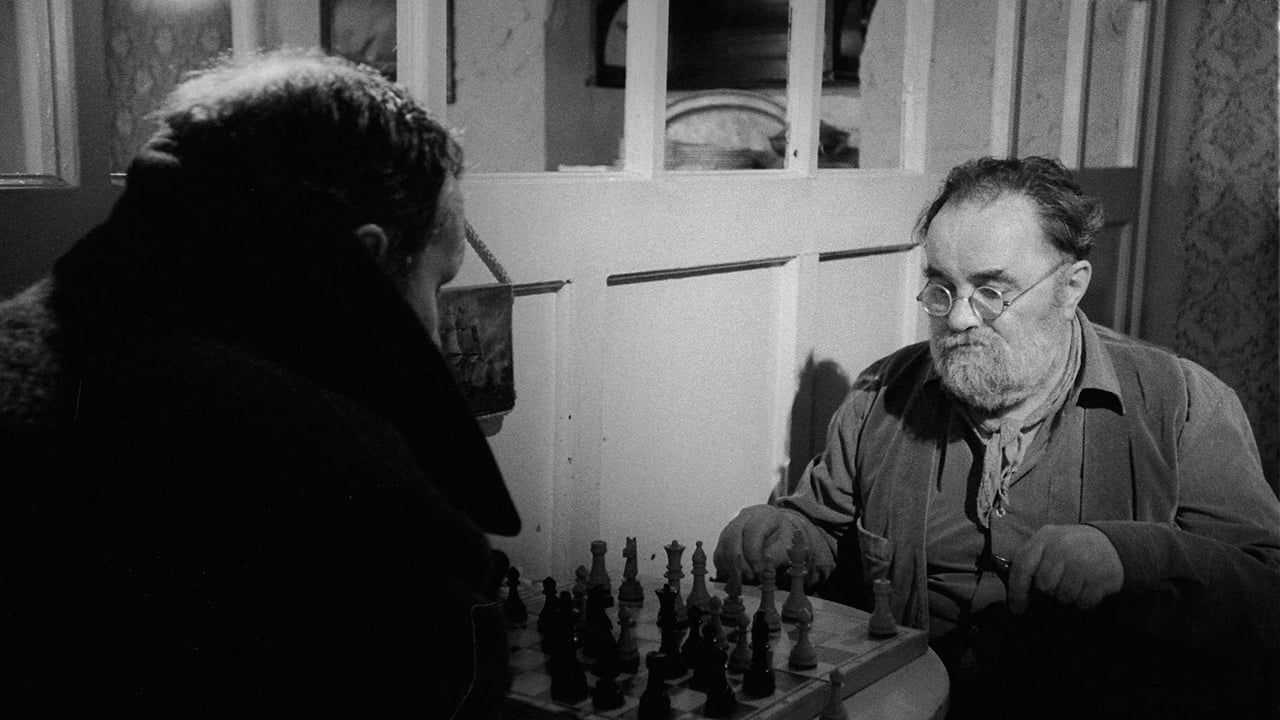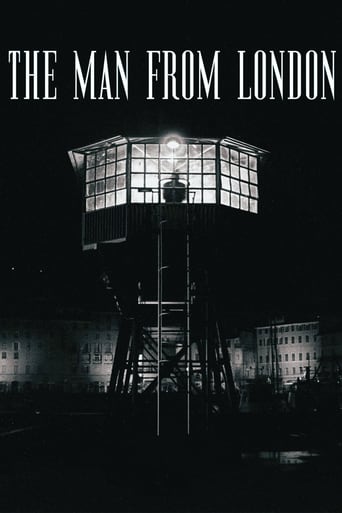

"All stories have resolved themselves. All that remains is time." - Bela TarrBela Tarr directs "The Man From London." The plot? Maloin is a grim-faced railroad employee. He sits in a signal cage all night, pulling giant levers which cause rail tracks and train signals to alternate. In other words, he makes choices for a living. These choices, of course, have ramifications; they literally "change the course of things".One day Maloin witnesses a murder, a small briefcase being lost in the scuffle. He retrieves this briefcase and opens it up to find six thousand dollars in stolen cash. Maloin faces a moral dilemma. Does he keep the money or does he return it to the authorities? It's a familiar, noirish plot, but Tarr handles the material in his own inimitable way. This is a world of infinite seas and lustrous blacks, the film's characters rarely speaking, Tarr's camera observing them all with agonisingly slow long takes. Many have complained that the film is "boring" and "listless", but these are characters who have long accepted a kind of slow and inevitable deterioration. They've chosen to live in complete isolation, succumbing to a kind of existential dead-lock; no amount of action will halt death, so they stew in their own private miseries.And so the antagonist of this film is time itself. Time is a monster, Tarr says in interviews, his Hungarian drawl like a discordant piano. Time sucks and draws blood, reducing its players to mechanical ghouls, alienated and resigned to fate.But of course Maloin sees a way out. This little briefcase of money could bring him happiness, couldn't it? The film thus becomes a sort of religious parable, the temptations of a new life seducing Maloin. Does he reject the money and embrace a kind of ontological damnation or does he embrace the money and hope for some brief respite? If you've seen Tarr's other films, you know the answer.Elsewhere the film uses the tropes of noir – high contrast lighting, men in coats, a crime, a moral dilemma, a prowling police inspector, cold urban spaces etc – but Tarr has flattened these signifiers and placed them within a world that is comprised of four clearly demarcated planes.There's the domestic space (the home in which we eat/sleep/defecate), the space of entertainment or amusement (the bar, where our hero plays chess, gets drunk etc), the space of labour (the railroad and harbour) and beyond (the infinite ocean). The first 3 spaces sit next to the ocean. They teeter fearfully beside this limitless mass of black, always threatening to fall in. The ocean - thick, black and inky - is the final plane. A plane of murder and perhaps spiritual and physical death.Indeed, water has such a strong impression on the inhabitants of this world that when Maloin sees his daughter sweeping water out of a shop - pushing back time - he immediately resolves to make her happy, forcing her to quit her job and buying her a fancy new coat. But of course it's no use. These are empty purchases, idyllic gestures which Maloin doesn't believe in anyway; he believes solely so that she may temporarily hope, the reverse of the characters in Tarr's "Damnation", who cut down the beliefs and hopes of others so that everyone might partake in a kind of communal misery. Significantly, when Maloin argues with his wife over the purchase, Tarr's instinct is to cut to the little girl mechanically eating a bowl of soup. Spoon after spoon she swallows...spoon...after...spoon...8/10 – Tarr seems to be repeating himself here, and aesthetically the film's not as strong as his best work. For those who find the film ponderously slow, watch it at x2 speed. Worth two viewings.
... View MoreCompletely & unbelievably pretentious. Forget beautiful cinematography, it was just long black & white shots & there are only so many times one can play on shadow & light before even the dimmest member of the audience gets the message. Forget the tragedy of the human condition, it's all been done before & in a much better, so much less pretentious way.As for the switching between English & French...why? Pretentious rubbish. I am both English & French & it annoyed ME!The symbolism was so heavy-handed it was like being hit with a sledgehammer. So little sublety that at times I was actually convinced it was a spoof!The director obviously felt that if he made a film boring & pretentious enough, everyone would think it was terribly 'deep' & judging by some the comments on here, he was right!
... View MoreTarr returns after a long absence. Unfortunately, it's not up to par. Well, I should say, I have much of the same problem with this film that I do with all of Tarr's films. I'm certainly not his biggest fan anyway. I love his aesthetic, and would definitely call him a genius just for his visual prowess. It's so extremely original. And he's so good at setting mood, although I should say that the mood of all of his films, at least his later, more well known films, is pretty close to the same. Dark, cold, lonely, the drudgery of life, etc. But as soon as the characters start to speak, I stop paying attention. I find most of the actual words of Tarr's films uninteresting, and, when the characters are talking, I start to realize that I don't find these people that interesting. They may look interesting, as Tarr captures their essence in severe close-ups, but they never say anything interesting. The Man of London unwisely adds plot to the mix. Tarr's earlier films have a wonderful meandering quality, where it feels like he's just capturing people going about their lives. That is true here to an extent, but this one has a pretty clear plot structure, and one that's been told often before: a man finds a pile of money that belongs to crooks, and he pays for it. It's not plot driven by any means, but that skeletal plot is followed, and it makes the film less interesting than Tarr's other films. Also, Tilda Swinton shows up as the protagonist's wife in what amounts to a cameo (she has about five minutes of screen time in this 2 hour and 12 minute film), and it's pretty distracting. There's a cute little nod to Satantango at one point, where people in a bar dance like they did in that behemoth. Also, the little girl with the cat from Satantango shows up as the protagonist's daughter. It's weird, because she looks exactly the same, except she's a woman now. A very, very creepy woman. Who probably still kills cats when nobody's looking.
... View MoreIn retrospect I am a bit more appreciative now, at the time of viewing not so much.My retrospect tells me there is a lesson here- "good things come to those who wait", I got that because Maloin didn't spend the money in the briefcase that he harpooned out, but in the end got a small monetary reward- I'm pretty sure that in the end he figured out that the "old guy" wasn't a cop, and thus changed the meaning of the briefcase altogether.I am sorry but I do not remember the "old guy's" name, he had INCREDIBLE bags under his eyes- that is really the only reason I kept watching him. A lot of the arduous black and white shots at the beginning were seamless, which was really awesome- but I guess made it a little harder to follow the plot and I really didn't know where I was in relationship to the boat that set up the beginning. I really couldn't visually SEE what was happening at first, and I never blinked for a second. I put the pieces together only at the end, although I wish I had seen whomever was in the shed one last time because it would have allowed me to enjoy the irony of the situation more. The irony is that the whole wife spiel wasn't even necessary because Maloin was already fulfilling his destiny in returning the briefcase... But that scene served as a segue and an excellent example of good on-screen crying. I enjoyed the deliberateness of the details- down to Maloin's money arranging and the way he picked up the bag of food, fabulous. I wondered if people use pounds in Hungary, but I suppose it doesn't matter. I think a lot of the problem for me was that there was too much distraction from the plot by the terrible dubbing. Not just the dubbing (which completely ruined Tilda Swinton's performance, she should have just learned Hungarian) but the post-production studio sounds, adding in the footsteps, etc. I hate this whenever it's too obvious, and it was way too obvious. Sure, the noir plot was cool in theory- but the dialog translated terribly and the beginning was not built up at all in an effective way, causing me to completely not care what happened to any of the characters in the end, whatsoever!Tilda Swinton and Maloin also had really no chemistry at all as husband and wife. It seemed to me that all the women in this film were helpless and angry except Maloin's daughter, who confused me with her lack of loyalty towards her father in the store but ultimately made me happy in the end because she was not a materialistic character, nor a beautiful Hollywood actress. Lastly, there was a typo in one of the subtitles, shame on whomever proofread that, or didn't. This was my first Tarr film in full (I don't think seeing clips counts), obviously something does not deserve excessive praise just because it's what's expected, but it also could have been a lot worse.
... View More